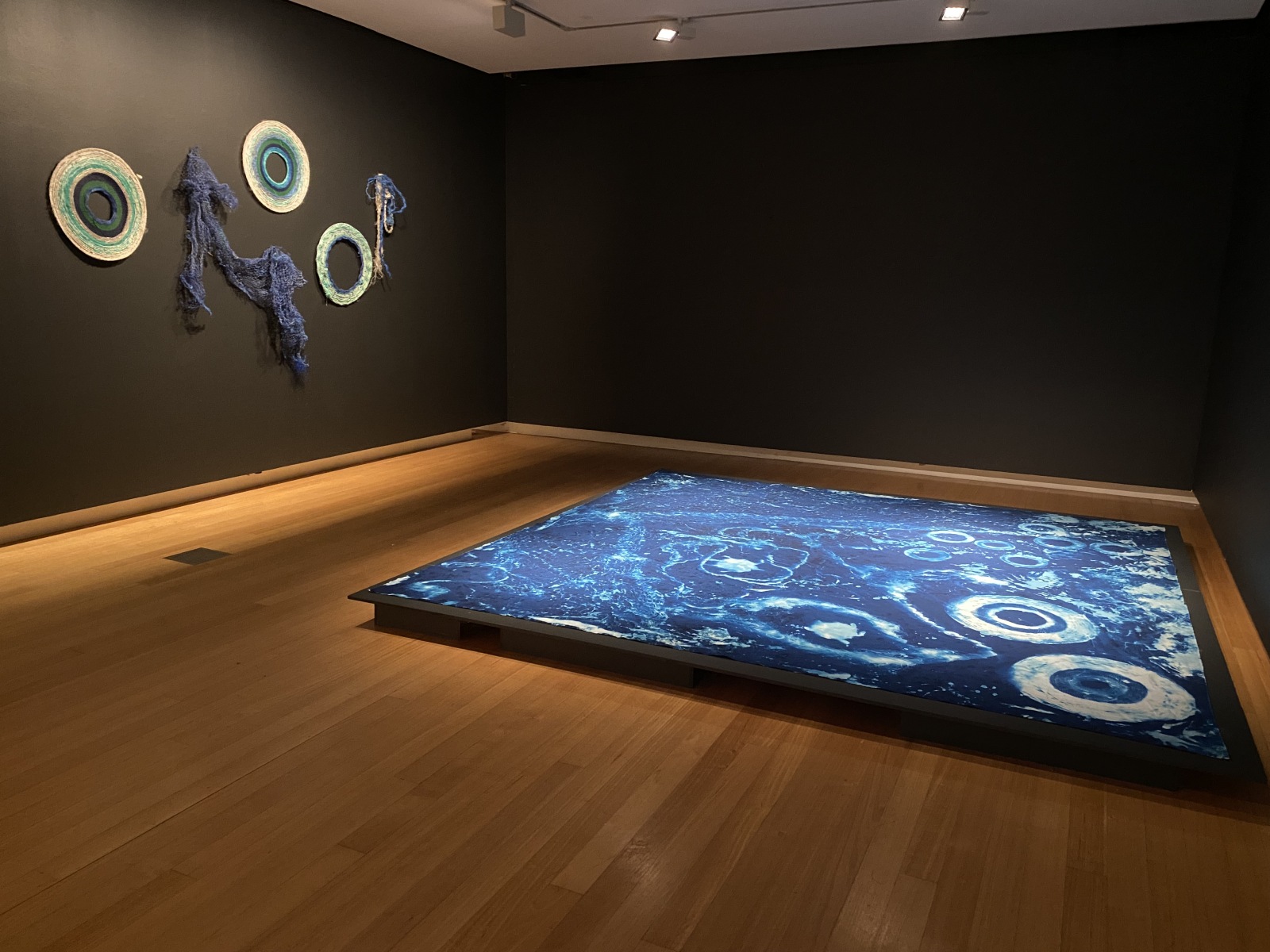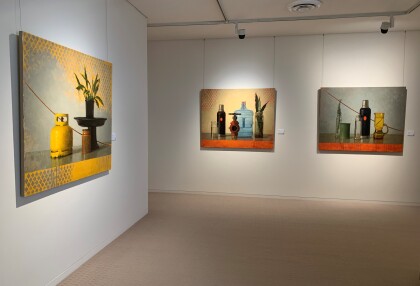Submitted Review
‘…charting spectacular careers and practices forged by QUT alumni.’
Thinking into Being: QUT Alumni Triennial
Out the front of QUT Art Museum, a wooden bench painted in Rainbow Pride colours marks the gallery as a safe space, and the university as a place where art, design and architecture effortlessly combine. Just beyond the seat, an installation by Emma Coulter extends from the gallery’s windows. Although only the latter is part of Thinking into Being, the two speak the same visual language of bold multichromatic geometry and serve to entice us into the show.
Thinking into Being showcases 11 alumni from the university’s Schools of Architecture and Built Environment, Creative Practice, and Design. In the gallery foyer, a brief exhibition text promises: “a wide-ranging exploration of the often unseen creative processes that bring into being the objects, products and experiences of our culture”. From here, the gallery splits to the left and the right; soundtracks call from each far corner.
Quandamooka artist, Elisa Jane Carmichael, fills the gallery’s furthest left space. Across a darkened wall, tangled blue and white ghost nets hang amongst her mother’s reworkings. By transforming the discarded fishing nets into circular textiles, Sonja Carmichael continues traditional weaving practices and cares for Country. On the floor, Elisa Jane Carmichael’s cyanotype outlines these shapes among little turtles in a deep ocean blue. And overhead a soundscape plays bird song, rushing waves and summer rains. Together, these works lay bare Carmichael’s place of making, her raw materials and her process, and equally function as finished works of art for display.
A ticking clock and tolling bell echoes from the gallery’s far right corner. If pleasant memories of native Australian soundscapes draw us to Carmichael’s work, this other soundtrack beckons with a sense of urgency. Kyle Bush’s ‘settlement’? or invasion (2020) charts key historical moments in Latrobe Valley’s mapping and asks audiences to acknowledge the relationship between map-making and power. This work might have just as easily appeared across the river in Griffith University Art Museum’s recent show, The Data Imaginary: Fears & Fantasies, which deftly showcased contemporary art and design practices engaged with data legacies, climate change and place.
Between these two highlights, Jennifer Marchant and Wei Jien’s are both well served by the exhibition. Marchant’s art practice is represented by a sculptural installation of massive, repeating, creased circular forms; documentation of a similar piece peppering a building’s facade, and a display case holding multiple maquettes. This is Thinking into Being’s most straightforward survey of an alumni’s creative process and practice. 27 photographs showcasing grand architectural interiors and documenting figures with hard hats, scissor lifts and cameras summarise Wei Jien’s career. In the accompanying wall text, Wei Jien explains each photograph, building an illuminating picture of her career in lighting design. Further moments of pleasure include Anthony Hearsay’s sublime astrophotography and the contrast of Benjamin Donnelly’s hyperreal spacecraft visualisations against Coulter’s bright abstractions.
Thinking into Being poses a difficult task, hoping to reveal the behind-the-scenes processes of significant alumni in diverse creative fields. Architecture and design are less readily suited to art museums than art, the creative processes behind these practices even less so. The exhibition might have further bridged this divide by more consistently displaying the hidden materials that fill creative studios or sharing more of the creatives’ processes in their own words. The soon-to-be released catalogue goes some way in addressing this. Despite this misgiving, Thinking into Being is an inspiring exhibition, charting spectacular careers and practices forged by QUT alumni. If the purpose of the exhibition is to inspire the next generation of emerging creatives, the curatorium has exceeded their task.
LRM
Louise R Mayhew
1. QUT Art Museum external view, featuring the rainbow bench and Emma Coulter, Spatial Deconstruction #26, 2021
2. Wall: Ghost net and rope collected from Minjerribah (North Stradbroke Island), Sonja Carmichael, Circles of Light and Life, 2019, Floor: Elisa Jane Carmichael, Dabiyil Wunjayi (Water Today), 2020
3. Jennifer Marchant, Artist’s studies, process notes, maquettes for Riverine and Untitled
4. Anthony Hearsey, Pho Ophiuchi Cloud Complex, 2021; Ptolemy’s Cluster, 2021; Orion Nebula, 2021; Lagoon Nebula (Hubble Palette), 2021
5. Installation view feat. Wei Jien various photographs 2012–2021
6. Clare Kennedy, Waste Terrazzo Table, 2021 and Gabion wall, 2021
7. Jessica Cheers, A love letter to the messiness and playful spirit of collaboration, 2021
8. Installation view feat. Amy Grey, QUT Art Museum Co-Design Experience, 2021 and Emma Coulter, Spatial Deconstruction #26, 2021 and ADAPTABLE CONSTRUCTION #2, 2015













No Comments